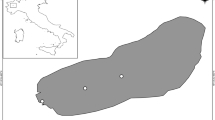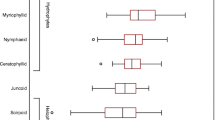Abstract
Autotrophic structure refers to the partitioning of whole-ecosystem primary production between benthic and planktonic primary producers. Autotrophic structure remains poorly understood especially because of the paucity of estimates regarding benthic primary production. We used a conceptual model for numerically exploring the autotrophic structure of 13 hemiboreal lakes situated in the Baltic Sea catchment. We also used diel variations in primary production profiles to graphically evaluate levels of light and/or nutrient limitation in lakes. The input morphometric data, light extinction coefficients and dissolved carbon parameters were mostly obtained from in situ measurements. Results revealed that cross- and within-lake autotrophic structure varied greatly: one lake was clearly dominated by benthic production, and three lakes by phytoplankton production. In the rest, phytoplankton production was generally dominant but switch to benthic dominance was possible. The modelled primary production profiles varied according to lake water clarity and bathymetry. Our results clearly indicate that the relative contribution of benthic primary production to whole-lake primary production should be taken into account in studies about hemiboreal and boreal lakes.





Similar content being viewed by others
References
Althouse B, Higgins S, Vander Zanden J. 2014. Benthic and planktonic primary production along a nutrient gradient in Green Bay, Lake Michigan, USA. Freshw Sci 33:487–98.
Armengol J, Caputo L, Comerma M, Feijoó C, García JC, Marcé R, Navarro E, Ordoñez J. 2003. Sau reservoir’s light climate: relationships between Secchi depth and light extinction coefficient. Limnetica 22:195–210.
Arst H, Erm A, Herlevi A, Kutser T, Leppäranta M, Reinart A, Virta J. 2008. Optical properties of Boreal lake waters in Finland and Estonia. Boreal Environ Res 13:133–58.
Asmala E, Stedmon CA, Thomas DN. 2012. Linking CDOM spectral absorption to dissolved organic carbon concentrations and loadings in boreal estuaries. Estuar Coast Shelf Sci 111:107–17.
Bertolo A, Carignan R, Magnan P, Pinel-Alloul B, Planas D, Garcia E. 2005. Decoupling of pelagic and littoral food webs in oligotrophic Canadian Shield lakes. Oikos 111:534–46.
Berman T, Pollingher U. 1976. Annual and seasonal variations of phytoplankton, chlorophyll, and photosynthesis in Lake Kinneret. Limnol Oceanogr 19:31–55.
Carpenter S. 1983. Lake geometry: implications for production and sediment accretion rates. J Theor Biol 105:273–86.
Chen Y, Qin B, Teubner K, Dokulil MT. 2003. Long-term dynamics of phytoplankton assemblages: microcystis-domination in Lake Taihu, a large shallow lake in China. J Plankton Res 25:445–53.
Chételat J, Amyot M. 2009. Elevated methylmercury in High Arctic Daphnia and the role of productivity in controlling their distribution. Glob Change Biol 15:706–18.
Cremona F, Hamelin S, Planas D, Lucotte M. 2009. Sources of organic matter and methylmercury in littoral macroinvertebrates: a stable isotope approach. Biogeochemistry 94:81–94.
Cremona F, Planas D, Lucotte M. 2010. Influence of functional feeding groups and spatiotemporal variables on the δ15N signature of littoral macroinvertebrates. Hydrobiologia 647:51–61.
Cremona F, Kõiv T, Kisand V, Laas A, Zingel P, Agasild H, Feldmann T, Järvalt A, Nõges P, Nõges T. 2014a. From bacteria to piscivorous fish: estimates of whole-lake and component-specific metabolism with an ecosystem approach. PLoS One 9:e101845.
Cremona F, Laas A, Nõges P, Nõges T. 2014b. High-frequency data within a modeling framework: on the benefit of assessing uncertainties of lake metabolism. Ecol Model 294:27–35.
Godwin SC, Jones SE, Weidel BC, Solomon CT. 2014. Dissolved organic carbon concentration controls benthic primary production: results from in situ chambers in north-temperate lakes. Limnol Oceanogr 59:2112–20.
Guildford SJ, Hendzel LL, Kling HJ, Fee EJ. 1994. Effects of lake size on phytoplankton nutrient status. Can J Fish Aquat Sci 51:2769–83.
Hecky RE, Campbell P, Hendzel LL. 1993. The stoichiometry of carbon, nitrogen, and phosphorus in particulate matter in lakes and oceans. Limnol Oceanogr 38:709–24.
Hecky RE, Hesslein RH. 1995. Contributions of benthic algae to lake food webs as revealed by stable isotope analysis. J N-Am Benthol Soc 14:631–53.
Higgins SN, Althouse B, Devlin SP, Vadeboncoeur Y, Vander Zanden MJ. 2014. Potential for large-bodied zooplankton and dreissenids to alter the productivity and autotrophic structure of lakes. Ecology 95:2257–67.
Holtgrieve GW, Schindler DE, Branch TA, A’mar Z. 2010. Simultaneous quantification of aquatic ecosystem metabolism and reaeration using a Bayesian statistical model of oxygen dynamics. Limnol Oceanogr 55:1047–63.
Jäger CG, Diehl S. 2014. Resource competition across habitat boundaries: asymmetric interactions between benthic and pelagic producers. Ecol Monogr 84:287–302.
Jeppesen E, Meerhoff M, Davidson TA, Trolle D, Søndergaard M, Lauridsen TL, Beklioglu M, Brucet S, Volta P, Gonzalez-Bergonzoni I, Nielsen A. 2014. Climate change impacts on lakes: an integrated ecological perspective based on a multi-faceted approach, with special focus on shallow lakes. J Limnol 73:88–111.
Kalff J. 2002. Limnology. New Jersey: Prentice Hall.
Karlsson J, Byström P, Ask J, Ask P, Persson L, Jansson M. 2009. Light limitation of nutrient-poor lake ecosystems. Nature 460:506–9.
Kirk JTO. 1994. Light and photosynthesis in aquatic ecosystems. 2nd edn. Cambridge: Cambridge University Press.
Lewis WM Jr. 1996. Tropical lakes: how latitude makes a difference p. In: Schiemer F, Boland KT, Eds. Perspectives in tropical limnology. Amsterdam: SPB Academic Publishing. p 43–64.
Liboriussen L, Jeppesen J. 2003. Temporal dynamics in epipelic, pelagic and epiphytic algal production in a clear and a turbid shallow lake. Freshw Ecol 48:418–31.
Liboriussen L, Jeppesen E. 2006. Structure, biomass, production and depth distribution of periphyton on artificial substratum in shallow lakes with contrasting nutrient concentrations. Freshw Biol 51:95–109.
Lindeman RL. 1942. The trophic-dynamic aspect of ecology. Ecology 23:399–418.
McBride GB. 1992. Simple calculation of daily photosynthesis by means of five photosynthesis-light equations. Limnol Oceanogr 37:1796–808.
Ministry of the Environment. 2009. Procedure for the establishment of bodies of surface water and a list of the bodies of surface water the State of which is to be established, classes of the states and the values of quality indicators corresponding to these state classes, and the procedure for the establishment of the classes of state (RTL 2009, 64, 941). Order from 28.07.2009 No. 44. Ministry of the Environment, 11 pp. (www.riigiteataja.ee/akt/13210253). Estonian.
Nõges T, Arst H, Laas A, Kauer T, Nõges P, Toming K. 2011. Reconstructed long-term time series of phytoplankton primary production of a large shallow temperate lake: the basis to assess the carbon balance and its climate sensitivity. Hydrobiologia 667:205–22.
Ott I, Kõiv T. 1999. Estonian small lakes: special features and changes. Tallinn: Est Environ Inf Centre.
Paavel B, Arst H, Reinart A, Herlevi A. 2006. Model calculations of diffuse attenuation coefficient spectra in lake waters. Proc Est Acad Sci 55:61–81.
Sand-Jensen K, Borum J. 1991. Interactions among phytoplankton, periphyton, and macrophytes in temperate freshwaters and estuaries. Aquat Bot 41:137–75.
Sand-Jensen K, Staehr P. 2007. Scaling of pelagic metabolism to size, trophy and forest cover in small Danish lakes. Ecosystems 10:128–42.
Scheffer M, Rinaldi S, Gragnani A, Mur LR, van Nes EH. 1997. On the dominance of filamentous cyanobacteria in shallow, turbid lakes. Ecology 78:272–82.
Solomon CT, Bruesewitz DA, Richardson DC, Rose KC, Van de Bogert MC, Hanson PC, Kratz T, Larget B et al. 2013. Ecosystem respiration: drivers of daily variability and background respiration in lakes around the globe. Limnol Oceanogr 58:849–66.
Thornton KW, Kimmel BL, Payne FE. 1990. Reservoir limnology: ecological perspectives. New York: Wiley.
Vadeboncoeur Y, Lodge DM, Carpenter SR. 2001. Whole-lake fertilization effects on distribution of primary production between benthic and pelagic habitats. Ecology 82:1065–77.
Vadeboncoeur Y, Vander Zanden MJ, Lodge DM. 2002. Putting the lake back together: reintegrating benthic pathways into lake food web models. Bioscience 52:44–54.
Vadeboncoeur Y, Jeppesen E, Vander Zanden MJ, Schierup HH, Christoffersen K, Lodge DM. 2003. From Greenland to green lakes: cultural eutrophication and the loss of benthic pathways in lakes. Limnol Oceanogr 48:1408–18.
Vadeboncoeur Y, Peterson G, Vander Zanden MJ, Kalff J. 2008. Benthic algal production across lake size gradients: interactions among morphometry, nutrients, and light. Ecology 89:2542–52.
Vander Zanden MJ, Vadeboncoeur Y, Chandra S. 2011. Fish reliance on littoral-benthic resources and the distribution of primary production in lakes. Ecosystems 14:894–903.
Wetzel RG. 1964. A comparative study of the primary production of higher aquatic plants, periphyton, and phytoplankton in a large, shallow lake. Int Rev Hydrobiol 49:1–61.
Acknowledgements
The authors are grateful to Toomas Kõiv, Ingmar Ott and Pille Meinson for assistance in data analysing. Sean C. Godwin (Simon Fraser University) provided great help for the benthic production calculations. This research was supported by Start-Up Personal Research Grant PUT 777 to FC and IUT 21-2 of the Estonian Ministry of Education and Research, Estonian Science Foundation grant ETF9102, the EU through the European Regional Development Fund, program “Research Internationalisation” project LIMNO, the Swiss Grant “Enhancing public environmental monitoring capacities” and MARS project (Managing Aquatic ecosystems and water Resources under multiple Stress) funded under the 7th EU Framework Programme, Theme 6 (Environment including Climate Change), Contract No.: 603378 (http://www.mars-project.eu).
Author information
Authors and Affiliations
Corresponding author
Additional information
Author contributions
FC, AL: Conceived of or designed study, performed research, analysed data, contributed new methods or models; FC, AL, LA, DP, PN, TN: Wrote the paper.
Rights and permissions
About this article
Cite this article
Cremona, F., Laas, A., Arvola, L. et al. Numerical Exploration of the Planktonic to Benthic Primary Production Ratios in Lakes of the Baltic Sea Catchment. Ecosystems 19, 1386–1400 (2016). https://doi.org/10.1007/s10021-016-0006-y
Received:
Accepted:
Published:
Issue Date:
DOI: https://doi.org/10.1007/s10021-016-0006-y




